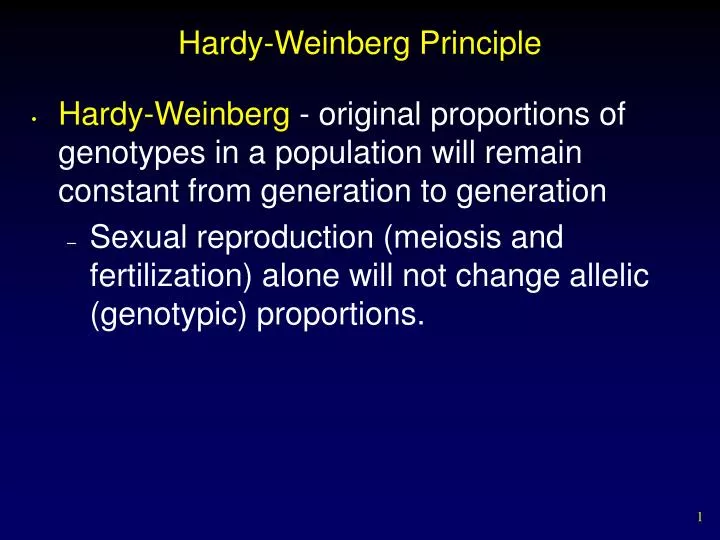


Because the maximum possible value for cannot exceed any allele frequency, the slider will sometimes move as you drag an allele frequency slider.įor purposes of illustration, the two traits are chosen to be hair color (brown or blond) and eye color (brown or blue), with brown dominant in both cases. In this Demonstration, the 16 possibilities for offspring genotypes are plotted on a two-dimensional bar chart. This can be quantified by a parameter, such that the composite haplotype frequencies are given by, ,, and. Linkage disequilibrium can occur if the allele frequencies influence one another.
Hardy weinberg principle full#
When there is no linkage between the alleles, say and with dominant frequencies and, respectively, the genotypes and phenotypes are simply products of two independent H–W distributions. What is the Hardy-Weinberg principle How does it explain the process of genetic driftWatch the full video at. The Hardy-Weinberg equilibrium can be generalized to haplotypes involving two (or more) loci. Natural selection and non-random, on the other hand, are believed to alter the gene frequencies resulting in. For example, external forces like mutations are reported to introduce new alleles, in turn disrupting the equilibrium of allele frequencies. Deviation from H–W equilibrium can be caused by one of several perturbing factors, including constrained mating, occurrence of mutations, random genetic drift, and natural selection. The Hardy-Weinberg principle studies the genotype frequencies in non-evolving populations. Hardy, the famous British mathematician (who took pride in the belief that none of his work would ever find practical application).

The principle was discovered independently by Wilhelm Weinberg, a German physician, and G. 1 - You discover a population of butterflies. The law essentially states that if no evolution is occurring, then an equilibrium of allele frequencies will remain in effect in each succeeding generation of sexually. Explain the Hardy-Weinberg equilibrium principle and its uses. Any changes in the gene frequencies in the population over time can be detected. Thus, contrary to some early misconceptions, a recessive trait can persist in a population. The Hardy-Weinberg formulas allow scientists to determine whether evolution has occurred. Since both the homozygous phenotype and the heterozygous (hybrid) phenotype will exhibit the dominant trait, the fractional occurrence of the dominant and recessive traits occurs in the ratio. If represents the frequency of a dominant allele and is the frequency of the corresponding recessive allele, the genotypes, , and occur in the ratios, persisting from generation to generation. In population genetics, the distribution of genotypes and phenotypes in many instances follows a Hardy-Weinberg equilibrium. The Hardy-Weinberg equation is a means by which the frequency of two alternate alleles can be predicted within a population.


 0 kommentar(er)
0 kommentar(er)
